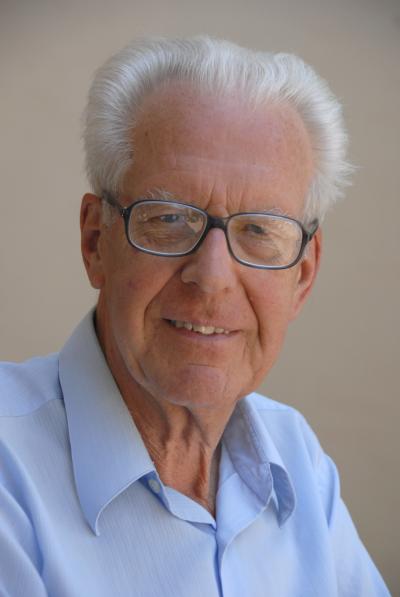Maarten Schmidt: wereldberoemd door ontdekking quasar

Na zijn kandidaats sterrenkunde in Groningen en promotieonderzoek in Leiden vertrok Maarten Schmidt (86) in 1959 naar het California Institute of Technology in de VS. Daar deed hij een ontdekking die hem wereldberoemd maakte: het bestaan van quasi-stellar objects, de quasars. Precies vijftig jaar geleden reden voor TIME aan hem, als een van de weinige Nederlanders ooit, de coverstory te wijden.
De editie van TIME is na vijftig jaar nog steeds op de website van het Amerikaanse magazine te vinden. ‘Exploring the edge of the Universe’ staat er naast zijn foto op de cover. Maarten Schmidt had kleine, sterachtige objecten gevonden die enorm ver van de Aarde af staan en een ongelooflijke hoeveelheid licht uitzenden. ‘Ik was een optisch astronoom en werkte met de 200 inch telescoop van CalTech’, vertelt Schmidt via de telefoon vanuit Californië, waar hij, zo’n twintig jaar na zijn pensionering, nog steeds woont.Radiosterrenkundigen gaven hem de positie van sterke radiobronnen aan de hemel en Schmidt keek of hij die objecten ook met zijn telescoop, in zichtbaar licht, kon zien en bestuderen.
Een van de ‘geluids’bronnen die Schmidt in december 1962 in beeld probeerde te krijgen, droeg de naam 3C273. ‘Toen ik op die plek keek, zag ik een relatief heldere ster.’ Alleen sterren in onze eigen Melkweg konden zo helder zijn, was destijds de gedachte, maar 3C273 zou volgens radiosterrenkundigen juist ver buiten de Melkweg staan. Schmidt analyseerde daarom het spectrum van de ster (de afzonderlijke golflengtes waarop deze licht uitzendt) om zeker te weten dat het licht niet van de radiobron kwam.
Stomverbaasd
‘Maar ik snapte niets van dat spectrum, het zag er raar uit’, herinnert Schmidt zich. Toen hij begin februari 1963 een kort artikel moest schrijven over 3C273 keek hij nog eens goed naar de golflengtes. ‘Ik meende iets van regelmaat te zien.’ Vervolgens deed hij iets dat eigenlijk onzinnig was: hij keek of er in het spectrum zogeheten ‘ roodverschuiving’ was te vinden, een kenmerk van objecten die op grote afstand van de Aarde staan. Sterren in de Melkweg staan relatief dichtbij en hebben nauwelijks roodverschuiving. ‘Maar dit object dus wel’, constateerde Schmidt. De ster bleek extreem ver weg te staan en zond evenveel licht uit als enkele tientallen miljarden sterren samen. ‘We waren stomverbaasd en het duurde nog jaren voordat theoretici een verklaring vonden.’ Het bleek dat zo’n sterachtige, een quasar, feitelijk een zwart gat is, dat materie aantrekt. Terwijl de materie in het zwarte gat verdwijnt, wordt een groot deel omgezet in licht.
Charles de Gaulle
De ontdekking trok uiteindelijk de aandacht van de redactie van TIME. ‘Ze wilden er al eerder over schrijven, maar er kwam telkens iets tussen. Ik moest bijvoorbeeld een keer wijken voor Charles de Gaulle. Uiteindelijk gebeurde het drie jaar later, in 1966.’ De redactie was wat onzeker over het stuk en las het hele artikel voor via de telefoon, zodat Schmidt fouten kon corrigeren. ‘Dat is keurig gebeurd.’
Schmidt werkte nog jaren aan quasars, hij bepaalde hoeveel er voorkwamen gedurende de geschiedenis van het Universum. ‘De meeste quasars vond je toen het heelal 3 tot 4 miljard jaar oud was. Daarna nam het aantal af. Dit geeft mij de meeste voldoening: ik heb iets van de verandering die het Universum heeft doorgemaakt, de kosmische evolutie, zichtbaar gemaakt.’
Tekst: René Fransen
Bron: Broerstraat 5, het alumnimagazine van de Rijksuniversiteit Groningen
